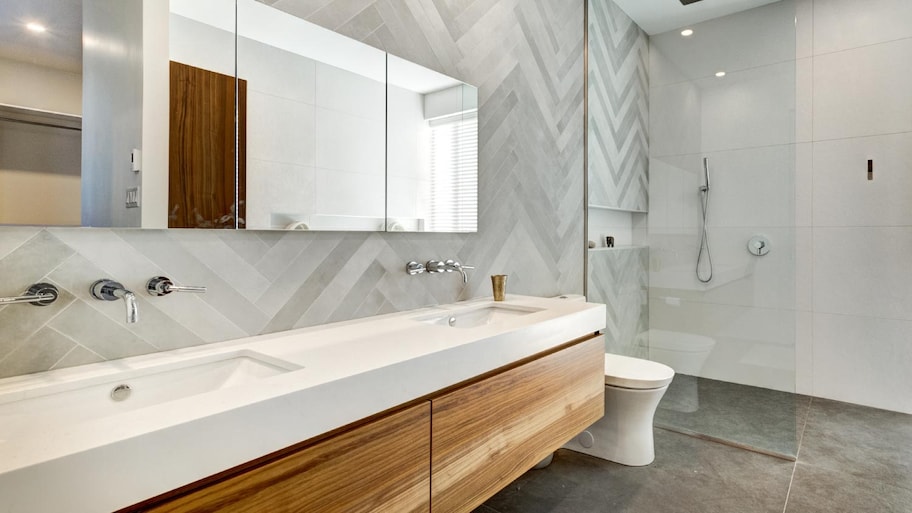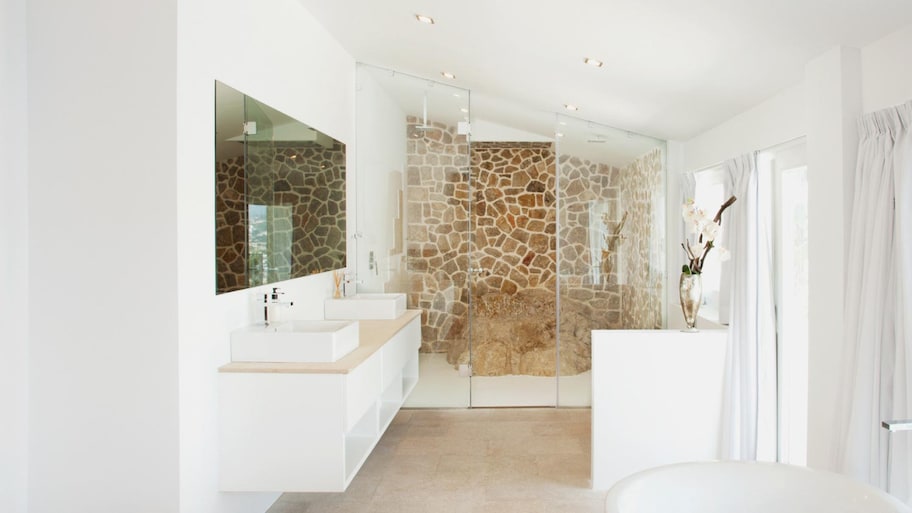How Much Does a Wet Room Cost to Install? [2024 Data]
Normal range: $4,000 - $15,000
Installing a wet room in your home costs $9,000 on average, but prices can be anywhere from $2,000 to $30,000, depending on the size of the room, the complexity of the plumbling, and materials used.


A wet room is a fantastic addition to any home that will give it a wow factor. It's an entirely waterproof, self-contained bathroom that typically features a sleek, modern design. As a result, it's become a trendy addition in modern homes. If you're looking to install a wet room in your home, expect to pay an average of $9,000, with a typical range between $4,000 and $15,000.
However, the final price depends heavily on how big of a space you want to convert and how complex the plumbing job will be.
- Average
- $9,000
- Low end
- $2,000
- high end
- $30,000
How Much Does It Cost to Install a Wet Room per Square Foot?
You can expect to pay about $225 per square foot to install a wet room on average; however, it can range between $175 and $600 per square foot, depending on how much labor is needed and the complexity of the plumbing work. You can break down the project into the following categories.
| Wet Room Project Category | Price per Square Foot |
|---|---|
| Plumbing | $13 – $20 |
| Labor | $6.50 – $10 |
| Drywall or plasterboard | $4.50 – $10 |
| Bathroom tiles | $13 – $25 |
| Miscellaneous materials | $13 – $50 |
These categories don’t include vanities, which you’ll pay for by the unit. Vanities usually cost between $200 and $1,000, depending on the quality, size, and materials.
As you can see, installing a wetroom can get expensive pretty quickly. Before you jump into the project, make sure you consider the pros and cons of a wet room to see if it’s worth the investment.
Wet Room Cost Factors

Installing a wet room will involve stripping down the room to the joists, plumbing the room, laying down drywall or plasterboard, waterproofing the space, laying tile, and installing vanities.
“There are many details in designing and building a wet room,” says Bob Tschudi, Expert Review Board member and Raleigh, NC-based general contractor. “Toilet paper holders need covers, floors need to be anti-slip, and there should be grab bars all around.”
Here’s how the costs break down in terms of materials and labor.
Materials
The materials alone for a wet room will usually come close to $5,000, and that’s not including the labor involved in installing everything. You can keep costs down by choosing less expensive materials, but they’re still going to cost a few thousand dollars in most cases. If you’re DIYing parts of the job, you’ll also need some tools.
| Supplies | Cost |
|---|---|
| Bathroom tiles | $3 – $18 per sq. ft. |
| Cement backer board | $0.75 – $1.50 per sq. ft. |
| Circular saw | $100–$400 |
| Craft knife | $10–$20 |
| Fixing washers | $15 – $25 |
| Grab bars and handrails | $30 – $500 each |
| Mirror | $40 – $300 |
| Power drill | $75–$200 |
| Screws | $15 – $25 |
| Sealing tape | $25 – $50 |
| Shower drain | $50 – $100 |
| Showerhead | $50 – $1,500 |
| Thinset mortar | $60–$300 |
| Thinset trowels | $15–$60 |
| Vanities | $300 – $1,000+ |
| Waterproof adhesive | $25 – $100 |
Plumbing
Finally, you will most likely pay between $1,000 and $10,000 to plumb the wet room. If the room is close to existing plumbing—if you’re converting or remodeling an existing bathroom—and it’s a relatively simple hookup, then costs will be on the lower end of the range. However, if it’s a complex job far away from existing plumbing, it will cost closer to the higher end.
For example, if you install a 40-square-foot wet room—requiring about 300 square feet of tiling, including the walls—with a standard showerhead, sink, and mirror, and you’re working with existing plumbing, you will most likely pay closer to the lower end of that range.
Size
The size of your wet room will play a big role in your total cost, with every additional square foot adding between $200 and $600 or more to your total. For a standard 40-square-foot bathroom, expect to pay between $8,000 and $24,000.
Many homeowners convert larger bathrooms to wet rooms. For an 80-square-foot luxury bathroom, you’re looking at a price range of between $16,000 and $48,000.
Lighting
Lighting fixtures for a bathroom usually cost around $550 each to install. Wet rooms are usually smaller than most other rooms in your home, so you’ll likely only need two overhead lights and one to two fixtures over the vanity. That brings your total for lighting to somewhere between $1,000 and $2,000.
Replacing or Removing Existing Fixtures
If you’re converting an existing bathroom to a wet room, you’ll need to pay your professional to remove your tub or shower, at a minimum. That service alone will cost between $150 and $500. You might also want to remove and replace your toilet and vanity to match the new space. That would bring the total for fixture removal to between $600 and $2,000.
Labor
You can expect the labor for the project to make up around 50% of the total cost, or an average of approximately $4,500. Labor fees can be as low as around $1,000 if you’re converting an existing bathroom and keeping some of the fixtures, but it can easily climb to $15,000 or more if you’re doing a complete renovation.
Either way, you’ll need to hire a few different professionals to get the job done:
Plumber: $50 to $200 per hour
Tiler: $30 to $120 per hour
Electrician: $50 to $100 per hour
General contractor: $50 to $150 per hour
Structural engineer: $100 to $250 per hour
If you have a larger space, you will add more hours to the project; therefore, the labor cost will go up.
Cost to Install a Wet Room Yourself
If you install a wet room yourself, it’ll cost you as little as $1,000 and as much as $18,000 for a standard 40-square-foot space based on the typical price range for materials alone. The cost will be higher if the space is larger than 40 square feet.
That means you could save $1,000 to $13,000 on labor by doing this project on your own. However, this is a difficult project that requires expertise. If you don’t do it correctly, you may have to tear out all the tiling and plumbing and do it again, which will add a huge cost to the project. Even if you make a small mistake and fail to waterproof the room properly, you could be looking at major water damage that could cost you more than you’d save by installing it on your own.
Plus, it’s always best—and sometimes legally required—to have a certified professional complete plumbing and electrical work for you. Since you’ll have professionals on site, and the risk of a mistake is so high, we recommend calling in a bathroom remodeling professional near you for an estimate.
Tips to Reduce Costs While Installing a Wet Room
Installing a wet room can be expensive, but there are a lot of ways to save money on the installation.
Shrink the Space
Size is one of the biggest cost factors for this project, so consider trimming down the planned size of your wet room. Reducing size by about 10 square feet will significantly affect the final price—usually reducing it by $2,000 to $6,000.
Shop Around for Tiles
The type of bathroom tile you choose makes a big difference in price. Ceramic and porcelain tiles have a wide range in cost based on their quality and brand. Shop around or ask your contractor to find tiles in the $3 to $10 per square foot range, rather than in the $15+ per square foot range.
Eliminate Some Extras
Perhaps you were planning on installing a new sink, vanity, and lighting fixtures in your wet room. You can potentially save hundreds of dollars if you do a partial remodel and keep some of your existing components. Of course, this is only an option if you’re converting an existing bathroom to a wet room.
Opt for Less Costly Extras
Even if you want to keep all of those extras, they usually have wide price ranges. Perhaps instead of a marble vanity countertop and real stone tiles, you opt for a granite countertop and porcelain tiles. If you are willing to compromise in some areas, you could save quite a bit.
Do Some of the Work Yourself
While you should always leave plumbing, electrical, and waterproofing work to the pros, there’s less of a risk in doing some of the finishing work yourself, like installing tiling, grab bars, and trim, and connecting lighting fixtures. Consider your level of DIY experience and think about whether you’d prefer to save time or money.
Frequently Asked Questions
A wet room is entirely waterproof, even outside of the designated curbless shower area, and it usually features tile floors, walls, and a walk-in shower that’s level with the floor. The shower in your bathroom is basically a mini-wet-room, so think of that concept expanded to the entire room. Any water that ends up on the floor of a wet room flows into a drain in the room, which is not the case in a traditional bathroom, which has a separate space for the tub or shower.
Turning an existing bathroom into a wet room is possible, but you will have to tear out your tub or shower, and you might have to remove existing walls and tiles to waterproof the entire room. You will then need to install new tiling, as well as fixtures, like a vanity and toilet. While this can get expensive, it’s more affordable than installing a wet room from scratch, especially when it comes to plumbing work.
Yes, a properly installed and waterproofed wet room will add value to your home. It's a nice modern feature that is sure to impress prospective homebuyers and can make your bathroom look bigger. On average the return on investment (ROI) for a bathroom remodel is between 50% and 60%, and since wet rooms are generally more desirable, you’re likely to see a slightly higher return for a wet room.

